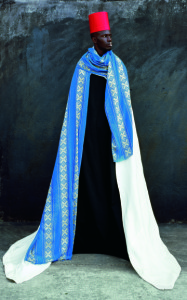
“Historically, feminist spirituality in art and thought (including cultural feminism) has searched for a language to counter patriarchal violence enacted upon female bodies. At a time of continued violence, MaÏmouna’s work invites a process of re-visiting these histories, and their significance to artists working currently, across generations and geographies.”
Yvette Greslé in her essay on Patrizia Guerresi Maïmouna.
‘new languages and feelings’: Patrizia Guerresi Maïmouna
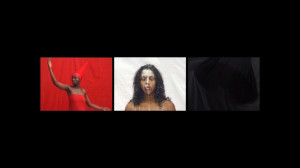 Oracles, 2007, DVD for projection, sound, 6.10, installation view.
Oracles, 2007, DVD for projection, sound, 6.10, installation view.
A pulsating, rhythmic sound, and then the suggestion of blowing wind. A woman’s voice begins to chant, a string instrument is audible, the musical form, its structure and arrangement, is Sufi. Three projections are visible; these appear first white, then red, followed by darkness. The figures of three women emerge simultaneously, projected onto screens, they are distinctly costumed in black, white and red respectively, and they rotate in a repetitive, deliberate circle. This video by Patrizia Guerresi MaÏmouna, six minutes, ten seconds in length, is titled Oracles (2007) and the music we hear, is by Fakhraddin Gafarov. Two of the women are veiled, one in black and the other in white, the third, in red, wears an exaggeratedly tall headdress, sculptural in quality, and a dress that leaves her arms and shoulders bare. The three women who perform in Oracles enact carefully choreographed movements and expressions as they turn in a circular movement: the figures appear to cross screens simultaneously and seamlessly, while time and space are rendered ambiguous. The figure in the red costume performs ritualized gestures – her arms are slowly, deliberately folded, and then stretched out, then folded and so forth. The veiled figure in black rotates from within the space of a black circle framed by a white ground: she is visible and then absorbed into the circle so that the imagined separations between her body and the circle are indistinct.
The bodies of the female figures in Oracles are transformed by the costumes they wear and, within the space of the work, suggest visual connections to MaÏmouna’s sculptures, composed variously of resin or materials such as bronze and enamel. These sculptures of veiled figures either appearing singularly or grouped in architectural environments and spaces include works such as Bui Bui Circle (1999), Fathima (2000) or Bui in Blue (2002). The musical forms deployed in Oracles and the dress of the female figures invoke the artist’s relationship to Islamic cultural practices and belief systems, which is also a subjective and personal relation, inflected by her habitation of geographies (which oscillate imaginatively and conceptually in her work) across the European and African continents. MaÏmouna was born in Italy and lives and works in Verona, Milan and Dakar, Senegal. She describes the significance of Islamic Africa to her work:
In this period [late 1980s-early 1990s] I made frequent trips to sacred places in Islamic Africa. My work was clearly influenced by the emotions I felt there and I began to explore new themes, which, without renouncing the sculptural aspects of classical Western figuration, allowed me to introduce new symbolic Afro-Oriental elements. I became interested in Islamic mysticism to which I converted. In Senegal this is represented by the Baifall Sufis. My work was enriched with new languages and feelings, giving me new artistic and spiritual strength … “[1].
MaÏmouna’s emphasis on ‘the emotions’ she felt visiting sacred places, her foregrounding of mysticism and spirituality and ‘new languages and feelings’, figure strongly in her work. Her practice encompasses sculpture, installation, photography and video art. She repeats, as if ritualistically, the elemental colors (red, white and black) which are present in historical representations of spirituality in art, and which take on different inflections across historically and geographically specific systems of signification and belief. Subjective and embodied experiences of spirituality and mysticism underpin MaÏmouna’s work. She also returns deliberately to particular substances, symbols and motifs. For example, references to milk recur both metaphorically and literally: ‘I consider this white liquid – which has fed all humanity from Juno to the goddess Kali, from Sarah and Mary to Fatima – a mystic sign and a universal symbol linking all women’. [2] The geometrical-spiritual form of the circle is also often repeated, and re-imagined, and its symbolism is brought into a visual relation with that of the milk: for instance, in the video work La via del latte (2000).
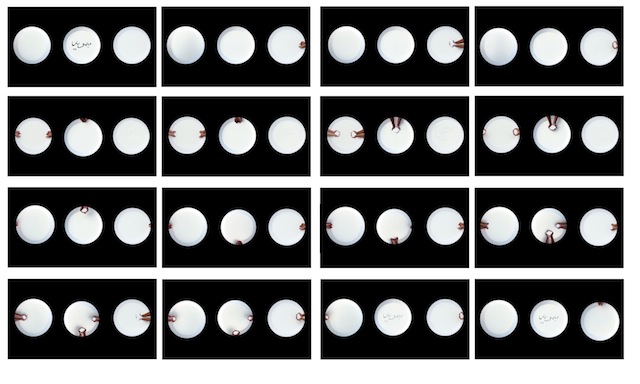 La via del latte, 2000, video loop, sound, 1.30, installation view.
La via del latte, 2000, video loop, sound, 1.30, installation view.
In this looped one minute, thirty second piece, accompanied by Sufi music, hands cup milk in a circular bowl within a black ground. In Oracles milk drips from the face of the veiled figure in white, and later, once the veil is removed, we see the substance dripping from her hair: a white line is drawn vertically from her forehead to her chin.
The human body, and in particular the female body, is central to MaÏmouna’s practice. Bodies are registered either as actual physical presences or more obliquely through the idea of fragments or absences. In La via del latte only hands are visible. Sculptural-architectural installations such as The Golden Mosque (2000) and The Golden Door (2001) incorporate a collection of white resin shoes, of various sizes, suggesting human presences which we cannot know or see. These shoes, without the presence of a wearer, invite points of connection with the work of Chiharu Shiota whose installations, deploying shoes (although actual shoes, rather than those cast), similarly explores the ideas and affective capacities of presence-absence. In particular instances, MaÏmouna inserts herself into her work, for example, the photographic work MaÏmouna’s Family (2006) where she appears with her daughters, holding in her hands a miniature copy of the actual larger portrait in front of us.
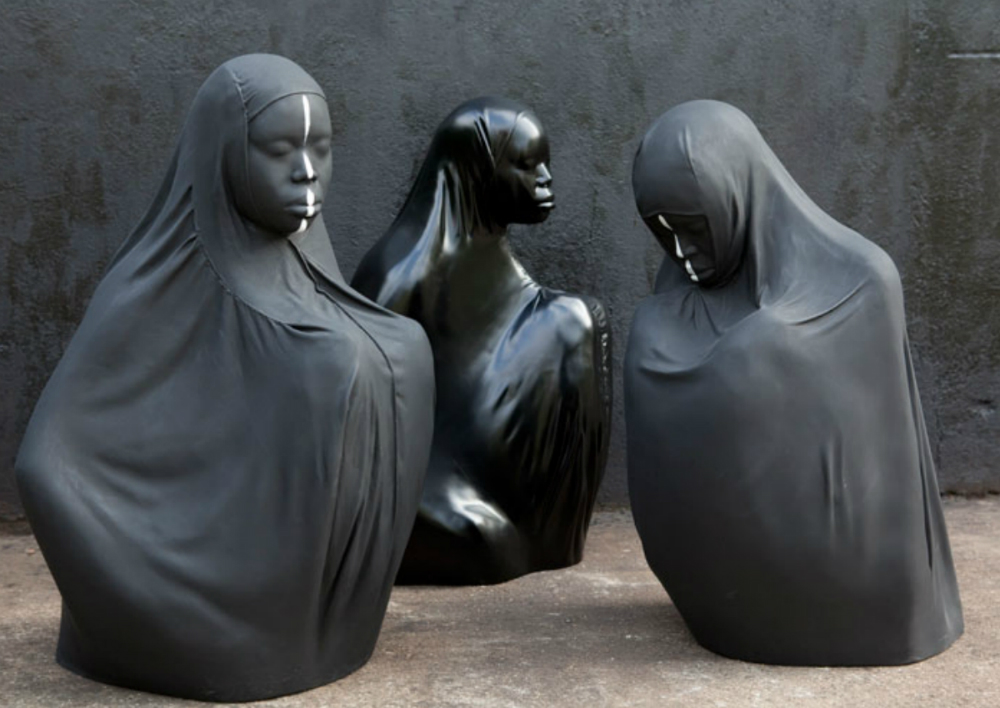 Black Kunte, 2003, black resin.
Black Kunte, 2003, black resin.
MaÏmouna has stated that her ‘early works were linked to conceptual experiences similar to Body Art in which photography and plaster casts were the main means for representing the cosmic symbiosis that I searched for in my body, nature and myth’. [3]. It is worth exploring the historical foundations of work which enters into a dialogue with the subjectivities of women artists and the relation of these to broader political concerns. Strands within performance and body art, by women artists, from the 1970s, have opened up debates about spirituality in art and have led to some interrogation of its political and critical validity. A 2009 article by Jennie Klein is a departure point for thinking about MaÏmouna’s work. [4] Klein has paid careful attention to feminist spirituality and related art practices, from the 1970s to the present day. Klein contextualises ‘feminist spirituality as it was constructed and articulated’ in the 1970s. [5] Feminist spirituality in art has been dismissed by feminist artists and critics informed by postmodern perspectives who brand this work naïve, unsophisticated’ and essentialist. They argue that it reductively reinscribes patriarchal ideas associating men with ‘culture and the mind and women with the body and nature’. [6]
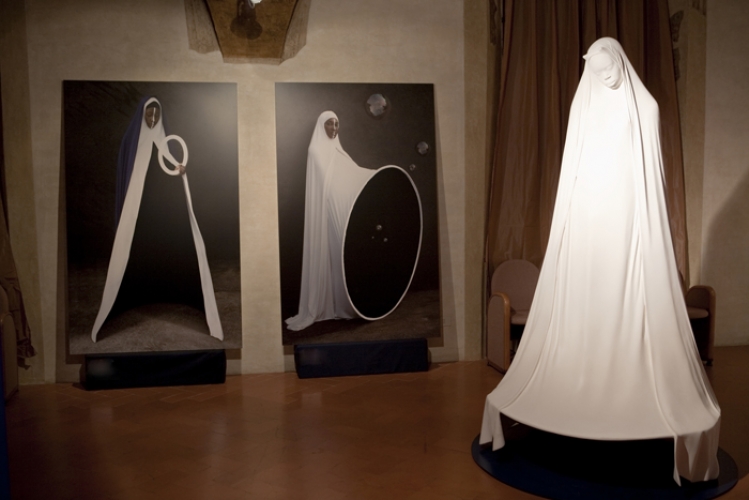 Installation view.
Installation view.
Klein notes that in the 1990s there was a renewed interest in performance and Body Art of the 1970s and 1980s. There was also some acknowledgement of ‘a particular strain of radical feminism most often referred to as “cultural feminism”’ which emphasised ‘feminist separatism, the value of female connections, and feminist spirituality/embrace of the Goddess’. [7] Klein draws attention to exhibitions which, in the late 1990s and into the new millennium, documented artists whose work engaged spirituality and feminist practice. She remarks that ‘there has been very little mention of the role played by feminist spirituality and belief in the Goddess for these artists’. [8] She cites Sexual Politics curated by Amelia Jones in 1996; Wack! Art and the Feminist Revolution (2007) and Global Feminisms: New Directions in Feminist Art (2007). Klein’s geographical focus is particular, the United States, encompassing artists who, across nationality, have lived and worked there. Importantly she emphasises the heterogeneity and specificity of artist’s relationships to feminist spiritualities. It is now commonplace that many artists working contemporaneously live and work across countries and continents, although how they do so and why, is particular.
Three ideas are identified by Klein as significant to feminist spirituality in dialogue with ‘cultural feminism’. Firstly, evidence of ‘matrifocal cultures’ in Ancient visual practices presented artists with visual repositories of ‘nonpatriarchal images’ which included ‘small, anthropomorphic sculptures, ephemeral cave paintings, and monumental stone structures from the prehistoric era’. [9] Secondly, feminist spirituality’s ‘recognition of the divine in all life forms’ opened up spaces for the honouring of nature and the body. [10] Klein refers here to Ana Mendieta’s Serie Árbol de la Vida (1976) ‘an earth-body work in which a mud-covered Mendieta pressed her body against a tree’. [11]. In MaÏmouna’s work, the motif and symbolism of the circle often appears in works that bring together a symbolic image of woman and the natural world. The title of the video Da’ Îrat (2003) refers to circle in Arabic: a woman, who is veiled, repeats circular movements with her body, hands, eyes and feet (face, feet and palms of hands are marked by the white vertical line familiar in MaÏmouna’s practice). [12]
 Da’Irat, 2003, DVD for projection, sound, 10, video still.
Da’Irat, 2003, DVD for projection, sound, 10, video still.
Da’ Îrat is punctuated by the temporal displacements produced by intervals of absence and darkness: ‘almost as though to mark the infinite time of the images’. [13] The video closes with the woman who, wearing a long mantle appears exaggeratedly tall. She stands in front of a tree in a landscape which for MaÏmouna suggests ‘the mysterious, inscrutable, and sacred spirit of the Great Mother’. [14].
The third idea, in Klein’s account of feminist spirituality and cultural feminism, relates to the importance given to ritual and performance which provided a critical entry point to the process of ‘reconfiguring avant-garde performance so that it had meaning and significance beyond the narrow concerns of the avant-garde art world’. [15] MaÏmouna’s practice functions in a historical relationship to the avant-garde and brings particular historical and geographical inflections which could be explored further. Strategies which encompass working across medium (deploying performance, the body, moving image and sound) are historically important to practices associated with the avant-garde in art. Also key is MaÏmouna’s relationship to subjectivity, the idea of multiple narratives and significations, spirituality and time: the idea of time is embodied, for example, by the video work and devices such as looping or deliberate temporal displacements woven into the fabric of the work itself.
 Dikhr, 2007, DVD for projection, sound, 5.34, video still.
Dikhr, 2007, DVD for projection, sound, 5.34, video still.
Similarly to Klein I assert that feminist spirituality deserves critical attention and this needs to be driven by careful consideration of context and history. The specificities of each artist’s concerns and creative and intellectual processes are important here. Historically, feminist spirituality in art and thought (including cultural feminism) has searched for a language to counter patriarchal violence enacted upon female bodies. At a time of continued violence, MaÏmouna’s work invites a process of re-visiting these histories, and their significance to artists working currently, across generations and geographies.[16] The experiences and subjectivities of women are not homogenous and the artist’s own articulated relation to subjective creative processes, intellectual concerns and art practices should be contextualised.
Donna Haraway, who Klein notes, has expressed ‘admiration for cultural feminists’ closed her ‘Cyborg Manifesto’ with the statement: ‘I would rather be a cyborg than a Goddess’ [17] The dystopian cyborg, Klein notes, was, by the 1990s, ‘a more attractive figure than the Goddess to a younger generation of feminists’ [18] The critique of essentialism (and the assumption of its belief in a predetermined identity) was a major aspect of this. Cyborg feminism was seen to be more attentive to the power relations of race and the need for inclusivity [19]. As feminist debates still demonstrate, across theoretical positioning, race and gender is still to be addressed in practice, in the art world and academe.
In the continued violence of the twenty-first century there is something critical and compelling about work that brings ideals of humanity, spirituality and empathy into the frame through a language that is affective and poetic. There is something hopeful about art’s capacity – visually, sonically, spatially, experientially, imaginatively – to counter the violence of empirical, didactic, authoritarian thought, and current political atmospheres of disillusionment in the aftermath of revolutions that bring no peace. Simultaneously, there is always the risk, in work that reaches for the spiritual and affective, of re-inscribing languages that obscure actual power relations (including those that may be embedded in spiritual practices and their deployment). These tensions bring critical depth to MaÏmouna’s work and open up further possibilities for reflecting on her significance as an artist.
Patrizia Guerresi MaÏmouna’s work appeared in London at 1:54 Contemporary Art Fair (16-19 October 2014) where she was represented by the M.I.A Gallery.
Courtesy the artist and M.I.A. Gallery.
Links of Interest
http://www.m-i-a-gallery.com/
http://1-54.com/artist/maimouna-guerresi/
http://www.maimounaguerresi.com/index.php
Endnotes
[1] MaÏmouna, Patrizia Guerresi, the Mystic Body. Milan: Prearo Editore, 2006, 184.
[2] Ibid. 13.
[3] Ibid. 184.
[4] Klein, J. ‘Goddess: Feminist Art and Spirituality in the 1970s’, Feminist Studies, Vol. 35, No. 3, The Politics of Embodiment (Fall 2009), 575-602.
[5] Ibid.580.
[6] Ibid. 577.
[7] Ibid. 579.
[8] Ibid. 579.
[9] Ibid. 580.
[10] Ibid. 581.
[11] Ibid. 581.
[12] MaÏmouna, Patrizia Guerresi, 2006, 134-139.
[13] Ibid. 134.
[14] Ibid. 134.
[15] Klein, J., 2009, 581.
[16] In articulating a concern with generations and geographies I draw on the work of Griselda Pollock in particular.
[17] Klein, J., 2009, 595.
[18] Ibid. 595.
[19] Ibid. 595.
Note editor: the artist is Italian but Senegal is her second ‘fatherland’. Sometimes she uses her Italian name – Patrizia Guerresi – sometimes her mixed name – Maïmouna Guerresi. Confusion as a result. On her website she is called Maïmouna Guerresi now.
